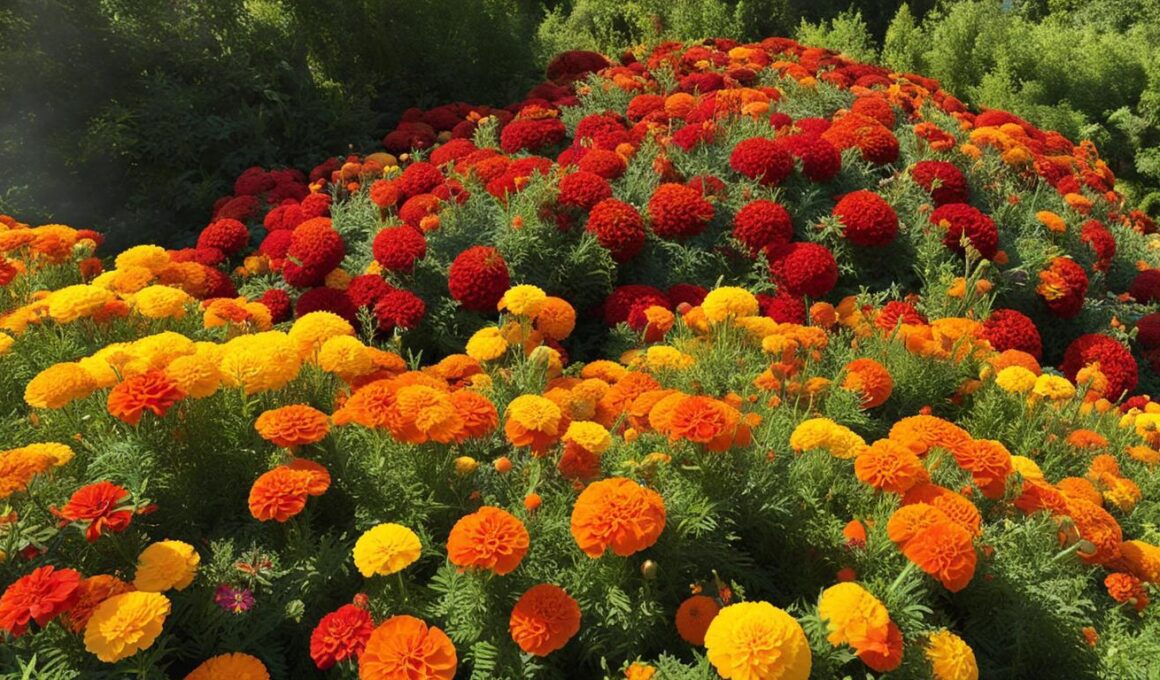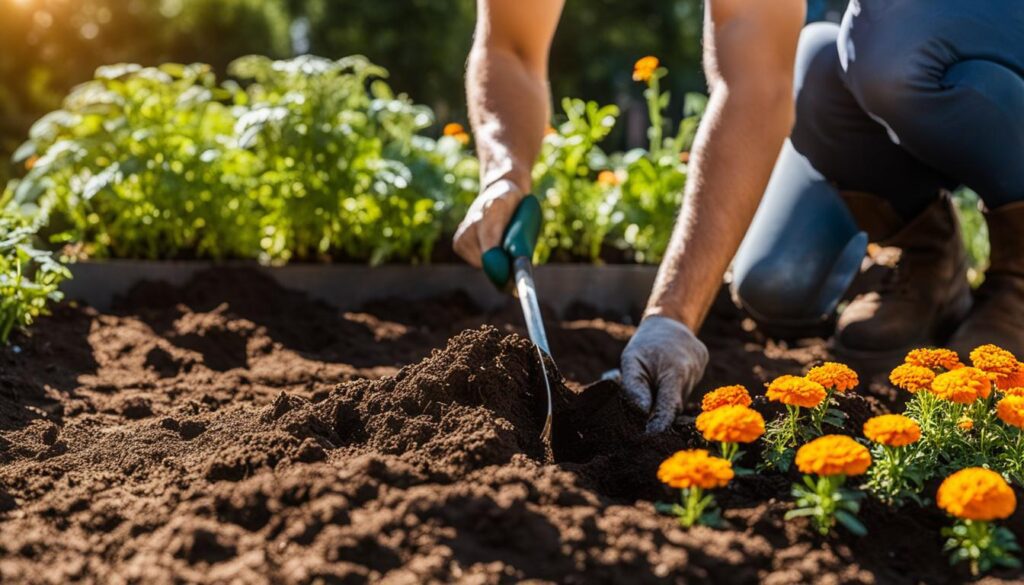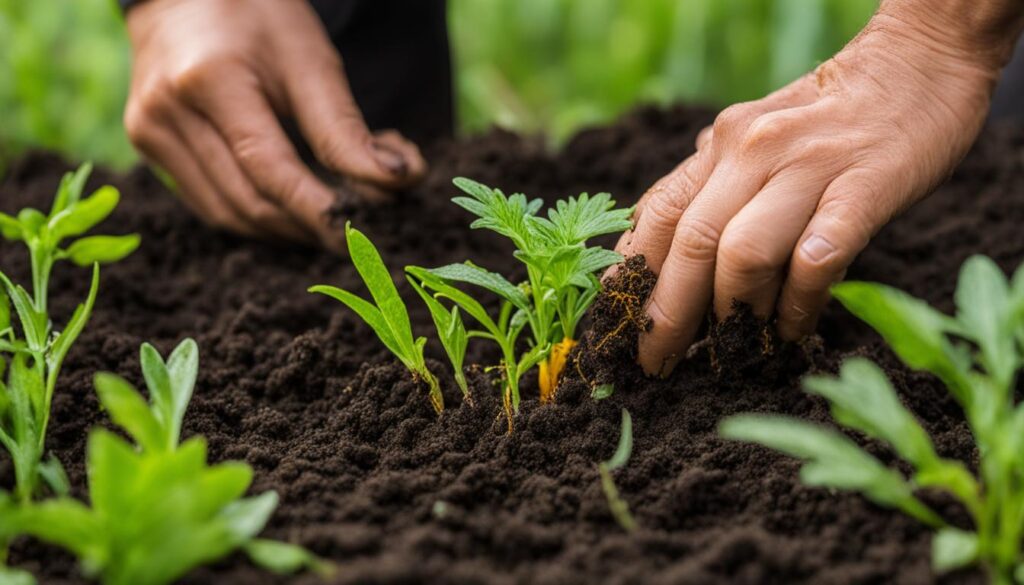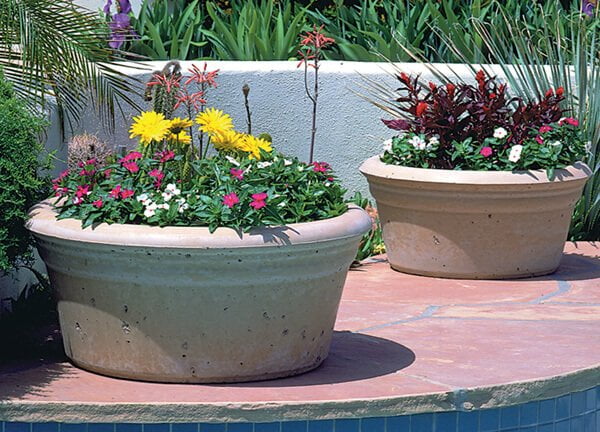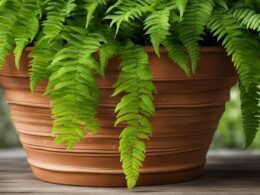Marigolds are a popular and cheerful annual flower that brings vibrant hues to summer and autumn gardens. While most marigolds are annuals, there are some varieties that are classified as perennials. Perennial marigolds include Mexican marigolds (Tagetes erecta) and French marigolds (Tagetes patula). These perennial species can thrive in a variety of climates and soil conditions. It’s important to note that not all marigolds are perennials, so it’s essential to choose the right variety if you want them to come back year after year in your garden.
Key Takeaways:
- Marigolds are mostly annual flowers, but there are perennial varieties available as well.
- Perennial marigolds can withstand various climates and soil conditions.
- Choose the right variety of marigolds to ensure they come back year after year in your garden.
- Perennial marigolds require proper care and maintenance to thrive.
- Consider adding perennial marigolds to your garden for long-lasting beauty and benefits.
Types of Marigolds: Annuals versus Perennials
Marigolds are a popular flower choice for many garden enthusiasts, adding vibrant colors and cheerful blooms to any outdoor space. When it comes to marigolds, there are two main types to consider: annuals and perennials. Understanding the differences between these two types can help you make informed decisions about which marigolds to include in your garden.
Annual Marigolds
An annual marigold, such as the French marigold (Tagetes patula), completes its life cycle in just one growing season. These marigolds produce beautiful blooms throughout the summer and fall but do not come back the following year. Annual marigolds are known for their compact size, making them an excellent choice for borders, containers, or filling in gaps in flower beds. They come in a variety of colors, including shades of yellow, orange, and red, adding a vibrant touch to any garden.
Perennial Marigolds
On the other hand, perennial marigolds have the ability to survive and bloom for multiple years. One example of a perennial marigold is the Mexican marigold (Tagetes erecta). These marigolds are larger in size and produce stunning, pom-pom-like flowers. Some French marigold varieties, such as the ‘Court Jester’ or ‘Lemon Gem,’ also fall into the perennial category.
Perennial marigolds are a great choice if you want long-lasting and low-maintenance flowers in your garden. They can be a beautiful addition to flower beds, cutting gardens, or even as focal points in larger landscaping projects.
Remember, not all marigolds are perennials. When selecting marigolds for your garden, be sure to check the specific variety and its classification to ensure you choose the right plants for your desired outcome.
Planting and Growing Perennial Marigolds
To successfully plant and grow perennial marigolds in your garden, follow these simple steps:
- Choose a sunny spot: Perennial marigolds thrive in full sun, so select a location that receives at least 6 hours of direct sunlight per day. This will ensure optimal growth and abundant blooms.
- Prepare the soil: Before planting, prepare the soil by loosening it with a garden fork or tiller. Remove any weeds or debris and amend the soil with organic matter, such as compost or well-rotted manure, to improve its fertility and drainage.
- Start indoors (optional): In areas with shorter growing seasons or colder climates, start perennial marigolds indoors about 4 to 6 weeks before the last frost date. Sow the seeds in seed trays or small pots filled with seed-starting mix, keeping them moist and warm until they germinate.
- Transplant outdoors: Once the danger of frost has passed and the soil has warmed up, transplant the seedlings outdoors. Dig a hole slightly larger than the root ball of each seedling, gently place it in the hole, and cover the roots with soil, firming it gently around the base of the plant.
- Water regularly: Perennial marigolds require consistent moisture, especially during the first few weeks after transplanting. Water them deeply but avoid overwatering, as excessively wet soil can lead to root rot. Allow the soil to dry slightly between waterings.
- Deadhead and prune: To encourage continuous blooming, remove faded flowers by pinching them off at the base. This will redirect the plant’s energy towards producing new blooms. Additionally, pruning the tops of the plants will promote bushier growth and more flowers.
Frequently Asked Questions
Do perennial marigolds require any special care?
Perennial marigolds are relatively low-maintenance plants, but they still benefit from regular care. Keep an eye out for any signs of pests or disease and take appropriate action if necessary. Additionally, provide a layer of mulch around the plants to suppress weeds and retain moisture.
Can perennial marigolds be grown in containers?
Absolutely! Perennial marigolds can be successfully grown in containers as long as the container is large enough to accommodate the plant’s root system. Ensure the container has drainage holes to prevent waterlogged soil, and use a well-draining potting mix specifically formulated for container gardening.
Care and Maintenance of Perennial Marigolds
Proper care and maintenance are essential for the health and longevity of perennial marigolds. By following these tips, you can ensure that your flowers thrive and continue to brighten your garden for years to come.
Watering
Perennial marigolds require regular watering, especially during hot and dry weather. However, it’s important not to overwater them, as these flowers prefer slightly dry conditions. Water deeply, allowing the soil to dry slightly between waterings. This helps prevent root rot and fungal diseases.
Fertilizing
While perennial marigolds are generally low-maintenance, they can benefit from occasional fertilization. However, it’s important to use a balanced fertilizer and apply it sparingly. Too much nitrogen can result in lush foliage with few blooms. Follow the instructions on the fertilizer package for proper application.
Protecting from Disease
One common disease that can affect perennial marigolds is powdery mildew. To prevent this fungal infection, avoid overhead watering, as wet foliage creates an ideal environment for mildew growth. Provide adequate air circulation by spacing the plants properly and removing any debris or dead leaves around them. If needed, treat the plants with a suitable fungicide according to the product instructions.
Mulching and Pruning
Applying a layer of mulch around perennial marigolds helps suppress weeds and retain moisture in the soil. This is especially beneficial during hot and dry periods. Mulch also helps regulate soil temperature and keeps the roots cool during the summer. Additionally, deadheading the faded flowers not only keeps the plants looking neat but also encourages more blooms. Pruning the tops of the plants can promote bushier growth and increase the overall flower production.
With proper care and maintenance, your perennial marigolds will reward you with their vibrant colors and long-lasting blooms. By providing suitable watering, fertilizing in moderation, protecting from disease, and practicing regular mulching and pruning, you can enjoy the beauty of these resilient flowers year after year.
Benefits and Uses of Perennial Marigolds
Perennial marigolds offer numerous benefits that make them a valuable addition to any garden. Here are some key advantages and uses of these beautiful flowers:
1. Pest repellent properties:
One of the remarkable benefits of perennial marigolds is their ability to repel harmful insects. Planting them as companion plants alongside fruits, vegetables, and other flowers can help deter pests and protect your garden naturally. The strong scent of marigolds acts as a natural deterrent against aphids, nematodes, and other insects, reducing the need for chemical insecticides.
2. Attract pollinators:
Perennial marigolds are a magnet for pollinators like bees and butterflies. Their bright colors and nectar-rich blooms attract these beneficial insects, which play a vital role in pollination. By including marigolds in your garden, you can create an attractive and welcoming environment for pollinators, promoting biodiversity and aiding in the reproduction of other plants.
3. Culinary and medicinal uses:
Some varieties of perennial marigolds, such as the signet marigold, have non-toxic flowers and leaves that can be used for culinary purposes. The feathery leaves of these marigolds have a pleasant fragrance and can add a unique citrusy or spicy flavor to salads, soups, and teas. In addition, certain medicinal traditions incorporate marigolds for their potential anti-inflammatory and wound-healing properties.
With their pest-repellent qualities, ability to attract pollinators, and versatile culinary and medicinal uses, perennial marigolds offer a range of benefits for both your garden and your well-being. Consider incorporating these vibrant flowers into your landscape to enjoy their natural beauty and practical advantages.
Conclusion
Perennial marigolds offer a beautiful and low-maintenance option for your garden. While most marigolds are annuals, there are specific species and varieties that can come back year after year as perennials. By selecting the right types and providing proper care, you can enjoy the vibrant colors of marigolds for multiple seasons.
To plant and grow perennial marigolds, choose a sunny spot with well-drained soil. Prepare the soil and start the plants indoors if you live in a colder climate. Remember to water them regularly and deadhead faded flowers to encourage continuous blooming. With minimal care and maintenance, your perennial marigolds will thrive and bring long-lasting beauty to your garden.
In addition to their aesthetic appeal, perennial marigolds offer several benefits. They repel harmful insects, making them great companion plants for your fruits, vegetables, and other flowers. These flowers also attract pollinators like bees and butterflies, contributing to a healthy and vibrant ecosystem in your garden. Some varieties, such as signet marigolds, can even be used in culinary and medicinal applications.
Consider adding perennial marigolds to your garden to enjoy their many advantages and create a vibrant and colorful outdoor space. With their ability to come back year after year, these flowers will be a beautiful and lasting addition to your garden landscape.
Can I Keep Marigold Plants Perennial in My Garden?
Yes, you can keep marigold plants perennial in your garden by unlocking marigold plants potential. With proper care and maintenance, marigold plants can thrive year after year, providing beautiful blooms and pest-repelling benefits. Ensure they have well-drained soil, sufficient sunlight, and regular deadheading to encourage continuous growth.
FAQ
Are all marigolds perennials?
No, most marigolds are annuals. However, there are certain species and varieties, such as Mexican marigolds and some French marigolds, that are classified as perennials.
How do I plant perennial marigolds?
Choose a sunny spot in your garden with well-drained soil. Prepare the soil by loosening it and adding compost. If you live in a colder climate, start perennial marigolds indoors before transplanting them outdoors. Water regularly and deadhead faded flowers to encourage continuous blooming.
What care do perennial marigolds require?
Water the plants regularly, especially during hot and dry weather. Be careful not to overwater them, as marigolds prefer slightly dry conditions. Fertilize sparingly and protect from powdery mildew. Mulch around the plants to suppress weeds and retain moisture. Deadhead the flowers to promote more blooms.
What benefits do perennial marigolds offer?
Perennial marigolds are known for repelling harmful insects and attracting pollinators like bees and butterflies. Some varieties, like signet marigolds, can be used in culinary and medicinal applications. Their leaves have a pleasant fragrance and a citrusy or spicy taste.





